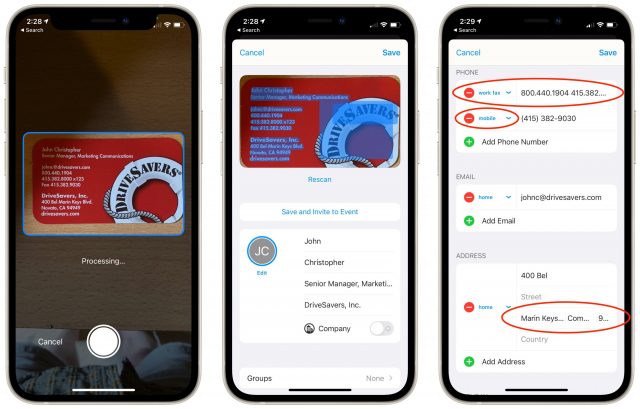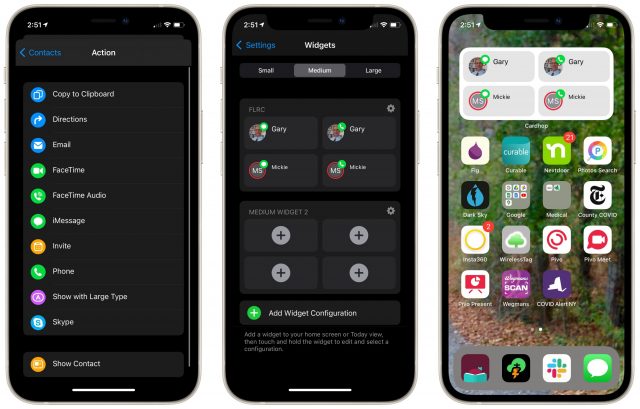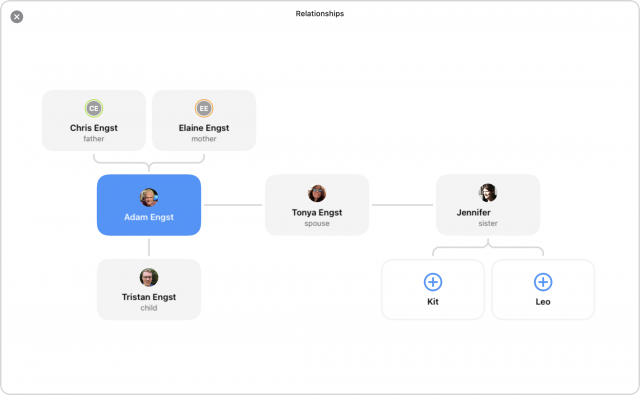Cardhop 2.0 Bundled with Fantastical in Flexibits Premium
Calendars and contacts go together like macaroni and cheese. Many events involve people, and if you’re going to have a phone call with someone or meet at their office, it’s handy to have their contact information associated with the event. That’s why we had combined packages like Now Up-to-Date & Contact, Claris Organizer, and Palm Desktop in the past. Apple now gives us Calendar and Contacts, and those who want more power, flexibility, and better interfaces can instead choose BusyMac’s BusyCal and BusyContacts or—my current favorites—Fantastical and Cardhop from Flexibits. The company has now released Cardhop 2.0 for the Mac, iPhone, and iPad.
I’ve written about Cardhop for both macOS and iOS (see “Cardhop Puts Contacts Front and Center,” 18 October 2017, and “Cardhop Rethinks How You Use Contacts in iOS,” 4 April 2019). The basics remain the same in Cardhop 2.0—notably, it still lives in the menu bar on the Mac. Flexibits remains steadfast in its belief in Cardhop’s contact-first approach—find a contact and then choose how you want to communicate with them. Unfortunately, much as I like Cardhop for standard contact lookups and editing on the Mac, I never use it to initiate communications with contacts, nor do I use it at all on the iPhone. In both cases, I think of the medium first—email, text message, phone—and then pull up the contact in the appropriate app. It’s how my brain works. Plus, I often rely on past content to inform what I’m saying.
While Cardhop 2.0 has some new features, most notable is the fact that Flexibits has moved to a freemium model that provides Cardhop 1.0’s basic features for free. Access to the new Cardhop 2.0 features requires a subscription, just as last year’s upgrade to Fantastical 3.0 provided basic calendaring for free but required a subscription for the new and advanced features.
However, rather than create yet another subscription, Flexibits has bundled Cardhop with Fantastical—for all of Apple’s operating systems—in a single Flexibits Premium subscription. Happily, the price remains the same despite the addition of Cardhop to the mix: $3.33 per month paid annually ($39.96). A family plan for up to five users costs $5.42 per month paid annually ($64.99). Month-by-month options are available, but I can’t see any reason to use those other than to extend the 14-day free trial.
New Cardhop 2.0 Features
I may not have a contact-first approach to communications, but I still appreciate Cardhop’s other features. In particular, the parser is great for looking up or adding contacts, or adding information to an existing contact. I’m a keyboard guy, so I enjoy typing at my apps. It even has solid printing capabilities, with support for lists, labels, and envelopes, and I like how it’s instantly accessible with a global hotkey.
New features in Cardhop 2.0 include:
- Business card scanning: This feature, which is only in the iPhone and iPad apps, does a decent job of importing data from business card scans. It was a huge win over typing information in my testing, but corrections were often required. As you can see in this scan of my buddy John Christopher’s card (he’s no longer at DriveSavers), Cardhop got a lot of information right, but combined two phone numbers, mislabeled the fax number, and stumbled badly on the street address. Other apps offer this feature, but it’s welcome in Cardhop.

- Widgets: Even if you don’t think in a contact-first way generally, you may appreciate Cardhop’s widgets. In iOS 14 and macOS 11 Big Sur, you can configure small, medium, or large widgets that encapsulate a person and an action. Some actions might be more easily accessed via Siri, but if you prefer looking and tapping, a widget for your most contacted people could be welcome.

- Relationships: In contact cards, you can add relationships, like mother, spouse, child, and so on. Those relationships can either be just static text or can link to other contact cards. The main use I’ve found for them is in printing holiday card labels for couples where I want to include both names (which Cardhop can’t do currently, but which Flexibits is investigating). Cardhop can now display a family tree of sorts for such relationships, though it can be a bit confusing, given that Jennifer is my sister, not Tonya’s. Although such a family tree doesn’t seem all that useful for individual contacts, if you link Cardhop to a corporate directory (Google or Office 365) with org chart details, that data could help you see where someone sits in the organization, who their supervisors and direct reports are, and so on.

- Invite to meetings: For those who like the contact-first approach, you can now use Cardhop to, for instance, “invite Contact Name to lunch on Thursday at 12:30” to create an event in Fantastical. It’s totally fine, but no easier than typing “lunch with Contact Name Thursday at 12:30” directly in Fantastical.
- Image attachments: You can now attach images directly to contact cards. I’d have to work to think of an example where this would be useful—a real estate agent attaching a picture of a client’s house, perhaps. Note that the slightly awkward process requires going through a pop-up menu and Open file dialog (Mac) or photo picker (iOS), so you’re unlikely to want to attach more than a couple of images.
After a few days of using Cardhop 2.0, I can’t say that it has changed my usage patterns at all. But it’s still a good contact manager, and the fact that it’s either free or bundled with Fantastical in the Flexibits Premium subscription (which I already have) makes using it an easy decision. If you’re looking for an alternative to Contacts, give it a try.
I stopped using Cardhop because the on the desktop it was very difficult finding a contact.Typing i series of letters tried to create a new contact regardless of what might be in your contact list. in iOs the default was “no contact” or something to that effect until you pressed search. Now you type a couple of letters and contacts that meet the criteria appear.
I would still like the contacts list disappear when you go to another application.
When I launched the app, the upgrade to version 2 was there. I upgraded and inmediately the upgrade to version 2.0,1 was available. I guess no combo
Hmm, that’s definitely not how it’s supposed to work or how it does for me. I type a few characters and matching contacts are shown with the preferred one expanded with full detail. Cardhop only offers to create a new contact once what I’ve typed is unique. That could require a fair amount of typing if, for instance, I wanted to create a contact for “Adam Engstrom,” I’d have to type “Adam Engstr” before Cardhop would stop matching my name.
In iOS, the slight difference is that there’s always a link under the text entry field for “Create a new contact” with what you’ve typed.
The new versions are a whole different story. They work Apple like, intuitively
Finally, cardhop is coming to speed on Mac. I have waited more than three years for the manager link in the contacts to work properly under the Office 365 Business Directory. Still I don’t like the navigation inside the app and there are still too many bugs.
How would this setup fit in Cardhop:
2 persons, each with their own Apple ID and personal contacts, some of them are family members.
1 of these persons has a second Apple ID for business contacts.
Optimal situation: personal contacts are shared/accessible for both, business contacts are only visible for the person with the business (not so much for privacy issues but mostly because of the number of contacts involved)
iCloud sharing helps, but on iOS devices it is invisible in which account a contact resides. This is sometimes confusing.
Any suggestions would be appreciated
I have used Fantastical since it was born, and Cardhop since it was born. Fantastical remains extremely useful. Cardhop is “ok,” primarily for the reason Adam cites: I’m not a “contacts-first” person, but an “action-first” person.
While the bundle makes good sense, the features of Fantastical have grown sprawling. Not everyone is on five different collaboration systems or requires large-group rvents and invitations. For those of us who don’t have those kinds of corporate requirements, $40/year is a lot to pay for basic calendar features. I’d happily buy a “non-premium” annual subscription for, say, $20, stripped of the “collaboration” stuff but replete with Fantastical’s other “appearance,” “weather,” (etc) features.
Without needing the excessive collaboration features, the price is just too high. (And the “free” version just never grows.)
I purchased Cardhop via the App Store on March 31. I got it mainly for the Finder Menu Bar access feature. I used Fantastical years ago but eventually moved to BusyCal before Fantastical was available for Mac OS, etc.
Now that Cardhop is part of a subscription bundle, I am wondering how long Cardhop support re Mac OS updates will last. . . I’m already resigned to no new features going forward. This kinda seems like a typical “Bait and Switch” deal at this point.